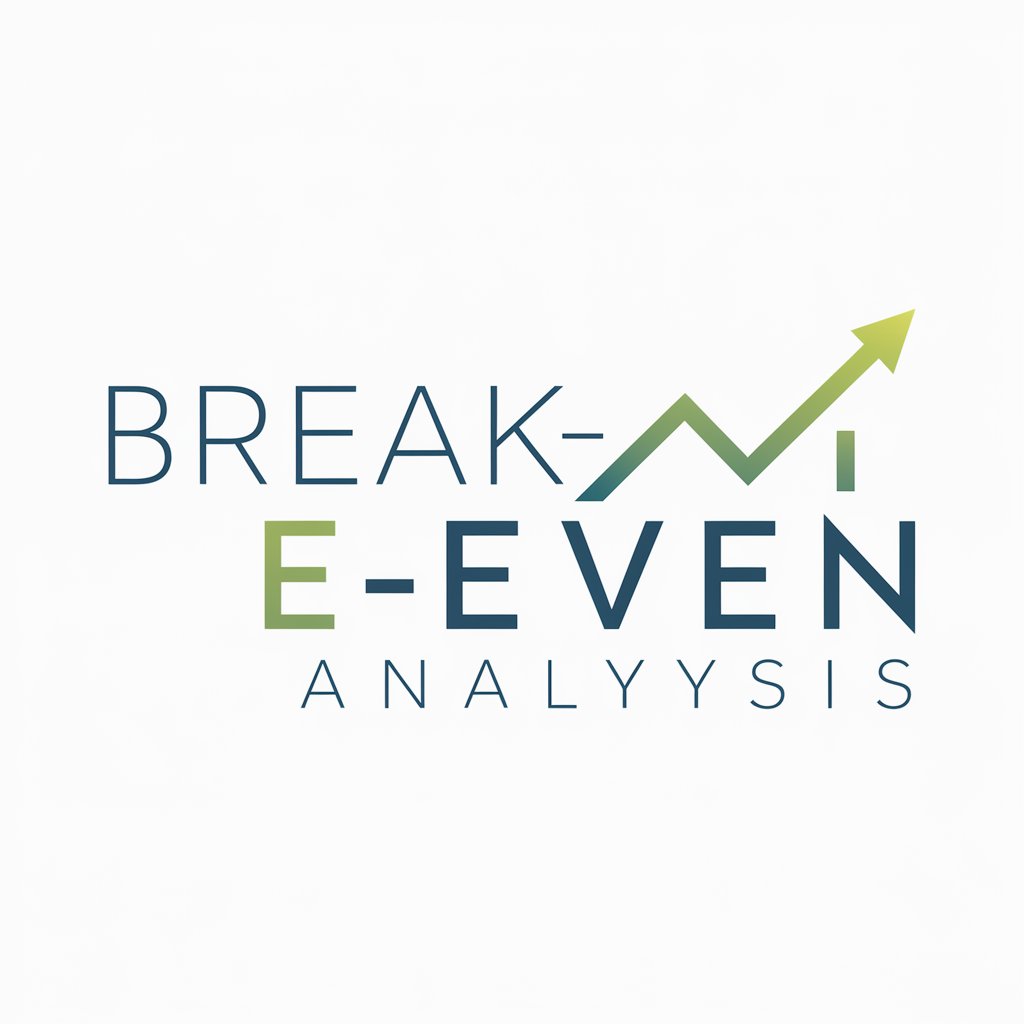Break-Even Analysis - Break-Even Analysis Tool

Hello! Let's find your path to profitability together.
Find your path to profitability with AI.
Can you help me calculate the break-even point for my business?
What impact will increasing my product price have on my break-even analysis?
How can I reduce my fixed costs to reach profitability sooner?
What strategies can I implement to improve my break-even margin?
Get Embed Code
Introduction to Break-Even Analysis
Break-even analysis is a financial calculation that determines the point at which a business's revenues equal its costs, indicating no net loss or gain. This analysis is crucial for understanding the viability of a business model, setting sales targets, and making informed pricing and investment decisions. It fundamentally involves the identification of fixed costs (expenses that do not change regardless of production volume), variable costs (expenses that vary with production level), and the revenue generated per unit sold. For example, a startup producing eco-friendly water bottles would use break-even analysis to determine how many units it needs to sell at a given price to cover the costs of production, including manufacturing and marketing. This analysis helps the company set realistic sales targets and pricing strategies to ensure the business becomes profitable. Powered by ChatGPT-4o。

Main Functions of Break-Even Analysis
Determination of Break-Even Point
Example
Calculating the exact number of products a bakery needs to sell to cover its costs.
Scenario
A bakery incurs $1,000 in fixed costs monthly and has variable costs of $2 per loaf of bread. At a selling price of $5 per loaf, break-even analysis helps determine the bakery must sell 334 loaves of bread to break even.
Profit Planning
Example
Using break-even analysis to forecast profits at different sales volumes.
Scenario
A tech startup examines how varying price points and sales volumes will affect their break-even point, helping them plan for profitability by adjusting their marketing and production strategies.
Pricing Strategy
Example
Evaluating the impact of different pricing strategies on the break-even point.
Scenario
A software company uses break-even analysis to assess how different subscription pricing models affect their revenue and cost structure, aiding in the selection of an optimal pricing strategy.
Cost Control
Example
Identifying opportunities to reduce costs and lower the break-even point.
Scenario
A manufacturing firm conducts break-even analysis to identify high variable costs areas, prompting a renegotiation with suppliers or investment in more efficient production techniques to reduce costs.
Investment Decisions
Example
Assessing the viability of new projects or investments based on their break-even points.
Scenario
An entrepreneur uses break-even analysis to evaluate the potential profitability of opening a new retail location, considering fixed setup costs and estimated variable costs against expected sales.
Ideal Users of Break-Even Analysis Services
Startups and Entrepreneurs
These users benefit from break-even analysis by gaining insights into how many units of their product or service need to be sold to cover costs, assisting in setting initial pricing and sales targets.
Small and Medium-Sized Enterprises (SMEs)
SMEs use break-even analysis to make informed decisions on scaling operations, launching new products, or entering new markets by understanding the financial implications and risks involved.
Financial Analysts and Managers
Professionals in finance utilize break-even analysis to evaluate the financial health of a company, plan for profitability, and make strategic decisions on cost management and investment opportunities.
Marketing Professionals
Marketing experts leverage break-even analysis to determine how sales volumes are impacted by marketing strategies and promotions, enabling them to optimize campaigns for profitability.

Guidelines for Using Break-Even Analysis
Initiate Your Journey
Start by accessing a reliable financial tool online for a complimentary trial, no registration required, mirroring the ease of yeschat.ai's approach.
Gather Financial Data
Compile all relevant financial information, including fixed costs, variable costs per unit, and the selling price per unit.
Calculate Break-Even Point
Use the formula: Break-Even Point (Units) = Fixed Costs / (Selling Price per Unit - Variable Cost per Unit) to determine the number of units needed to cover all costs.
Analyze Results
Evaluate the break-even analysis results to understand how many units need to be sold to cover costs and start making a profit.
Adjust and Optimize
Experiment with different scenarios by adjusting your costs, selling price, or both to see how changes impact your break-even point, guiding strategic business decisions.
Try other advanced and practical GPTs
Money Mentor
AI-powered financial guidance at your fingertips.

The Ultimate Writing Style Profiler
Decoding Your Writing DNA with AI

Ava
Empowering design with AI insights

Scientific
Empowering Science with AI

Templated API Assistant
Automate image and PDF creation with AI

Assitant API Creator
Empower your apps with AI chat capabilities

Corporate Loan
Empowering businesses with AI-driven loan solutions

IAS Expert Guide
Empowering financial insight with AI

Debt Management
Empowering Financial Freedom with AI

Return on Equity (ROE)
Empower financial decisions with AI-driven ROE insights.

Basketball Betting Analyst
AI-powered Precision in Betting Analysis

Caroline Lambert : Experte Musique en Ligne
Elevate Your Music Journey with AI

In-Depth Q&A on Break-Even Analysis
What exactly is Break-Even Analysis?
Break-Even Analysis is a financial calculation to determine the number of products or services a business needs to sell to cover its costs, highlighting the point at which revenue equals expenses.
Why is Break-Even Analysis crucial for startups?
For startups, it's vital to understand when they will start generating profit beyond covering their initial and operational costs, helping in strategic planning and risk management.
Can Break-Even Analysis help in pricing strategies?
Yes, by understanding the costs involved and the volume needed to break even, businesses can set more informed pricing strategies to ensure profitability.
How does changing the selling price affect the break-even point?
Increasing the selling price, assuming costs remain constant, will lower the break-even point, allowing profitability with fewer sales. Conversely, decreasing the price raises the break-even point.
What's the role of variable costs in Break-Even Analysis?
Variable costs directly impact the break-even point. Lower variable costs reduce the amount needed to break even, making it easier to achieve profitability.
